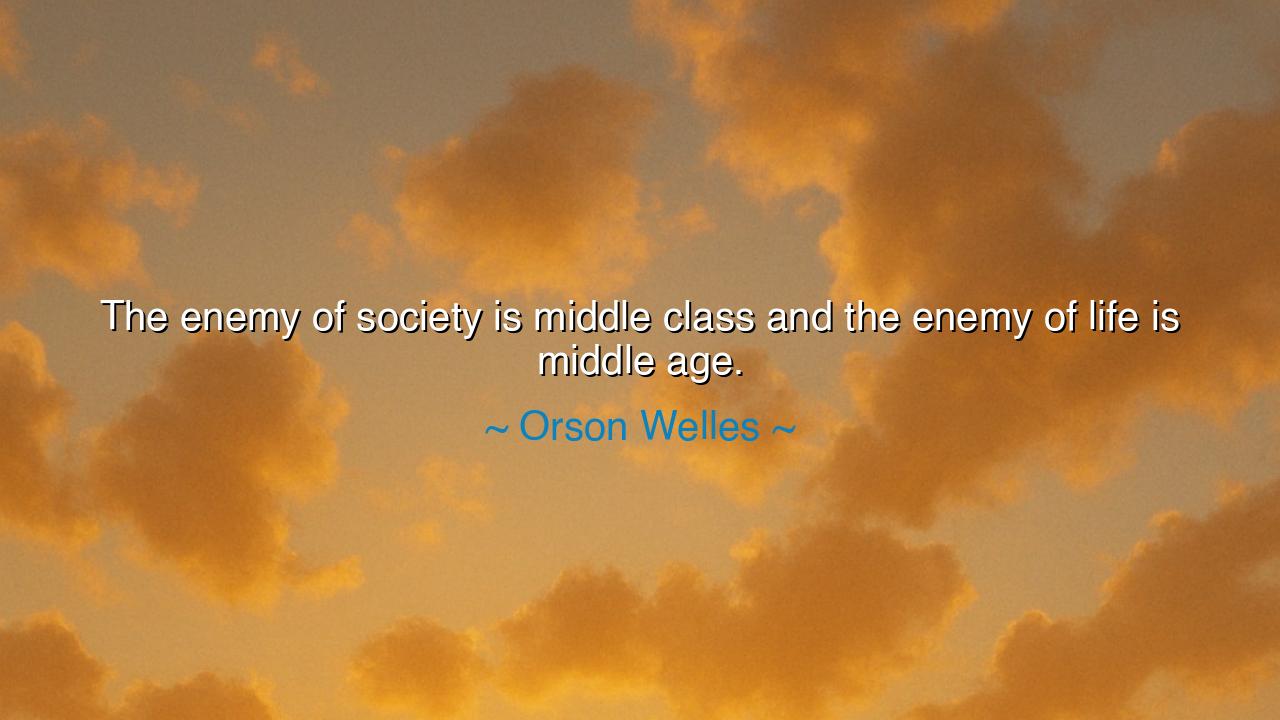
The enemy of society is middle class and the enemy of life is






"The enemy of society is middle class and the enemy of life is middle age." These words, spoken by the visionary Orson Welles, cut deep into the heart of society’s understanding of class and life. At first glance, Welles’ provocative statement seems to challenge the very essence of stability and comfort that the middle class represents. In his bold assertion, Welles is not merely attacking a social class or a stage in life; he is pointing to the complacency and conformity that often accompany both the middle class and middle age. The middle class, with its yearning for security and predictability, and middle age, with its inclination to settle into routine, can both become forces that prevent growth, change, and the pursuit of greater purpose.
In the ancient world, the notion of society’s enemies was not unfamiliar. The philosophers of Greece, especially Plato and Aristotle, understood that human beings are most powerful when they are in pursuit of virtue, wisdom, and truth—ideals that demand growth, challenge, and a continual reshaping of the self. In their view, society’s stagnation—its tendency to cling to outdated norms and forms of comfort—could prevent individuals from realizing their true potential. Plato’s Republic describes the ideal city-state, one where individuals are not bound by their desires or by societal pressure, but instead are free to pursue justice, truth, and the common good. To be trapped in the safety of the middle class, where one simply seeks comfort and status, would have been seen as a form of spiritual decay, an enemy of the soul’s deeper journey.
Welles, in his own time, saw this truth reflected in the complacency of the middle class, particularly in the post-World War II era, when the American dream was largely defined by owning a home, getting a steady job, and striving for material success. The pursuit of comfort—without a deeper sense of purpose or intellectual challenge—had taken root in society. The middle class had become so focused on external markers of success that they had neglected the internal journey—the pursuit of higher meaning and the questioning of established norms. To Welles, this was the true enemy of society, as it stifled creativity, individuality, and the desire to push beyond the status quo. It was a complacency that prevented the spirit from soaring.
Let us consider the life of Socrates, whose very existence was a challenge to the complacency of his time. Socrates, though a man of humble means, was no stranger to the ideals of the middle class—a life focused on comfort and stability. Yet, he chose a path that defied the values of his time. He lived not for wealth, nor for societal approval, but for the pursuit of wisdom and the questioning of established norms. Socrates believed that the soul’s purpose is found not in the material comforts of the world, but in the unrelenting search for truth. His life was a testament to the idea that one must always be willing to challenge the comfort of the middle class and reject the idea that stability and routine are the ultimate goals of life.
As for the enemy of life—middle age—Welles’ remark strikes at the heart of personal transformation. In youth, we are filled with dreams, ambitions, and a natural desire to change the world. We chase after purpose, hungry for new experiences, always seeking growth. But as we enter middle age, we can sometimes fall victim to the slow creep of routine and settling. Middle age, Welles suggests, can be the point where we stop challenging ourselves, where we begin to accept things as they are, and where the fire of youthful ambition begins to fade. This is not to say that middle age is inherently bad; rather, it is the complacency that can accompany it that Welles warns against. It is the point where people often become comfortable in their lives, where they no longer strive to break through their limits or to question their assumptions.
Look at the example of Leonardo da Vinci, a man who never allowed middle age to rob him of his youthful curiosity. Even as he grew older, he continued to push the boundaries of knowledge, art, and science. Da Vinci never allowed himself to become stagnant; he was driven by the same insatiable hunger for discovery that marked his youth. This tireless pursuit of innovation and growth is a powerful example of how one can transcend the limitations of middle age—by refusing to become complacent and always seeking new challenges. Da Vinci’s life reminds us that, no matter how many years we accumulate, we must always remain in pursuit of the new, the unseen, and the undiscovered.
O children, let us heed the wisdom of Welles’ words and recognize that both the middle class and middle age are not enemies by their nature, but by the complacency they often bring. The middle class, with its focus on materialism and comfort, can be a trap that keeps us from exploring the deeper mysteries of life, while middle age can be a time where we lose the drive to challenge ourselves, to grow, and to change. But it need not be so. Let us remain restless in our pursuit of truth, growth, and self-transformation, whether we are young or old, rich or poor. Let the quest for meaning, purpose, and understanding always propel us forward, for only in the refusal to accept complacency can we truly live.






AAdministratorAdministrator
Welcome, honored guests. Please leave a comment, we will respond soon